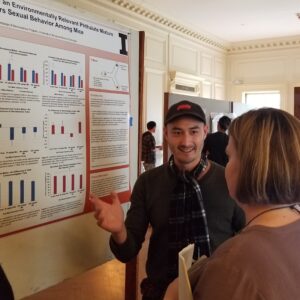RESEARCH INTERESTS
The overall goal of the Mahoney lab is to determine when and how endocrine signals regulate the brain and behavior.
Research in the Mahoney lab seeks to understand how endocrine disrupting chemicals (EDCs) can impact neural structures that regulate behavior. Humans and animals are exposed daily to endocrine disrupting chemicals (EDCs) through ingestion, inhalation, or dermal contact. We investigate how EDCs, either as a single metabolite or in environmentally relevant mixtures, can alter anxiety-like behaviors, sleep and biological rhythms, learning and memory, and reproductive behaviors. We examine the expression of genes and proteins in brain regions that regulate these behaviors. We are also interested in the effects of toxicant exposures that are given during different windows of exposure (prenatal, adolescence, adult).
Below are some descriptions of some major projects in the lab.
 Project 1: Assess the impact of environmental exposures on reproductive behaviors in mice.
Project 1: Assess the impact of environmental exposures on reproductive behaviors in mice.
Phthalates are ubiquitous plasticizers used in food containers, fragrances, personal care products, and medical tubing. We are investigating how these chemicals, either as a single metabolite or in environmentally relevant mixtures, can alter behavior and associated neural structures in mice. We are testing the hypothesis that developmental exposure to a phthalate mixture decreases fertility by having an adverse impact on sexually dimorphic brain areas and reproductive behaviors. We are using behavioral tests to assess if reproductive behaviors such as partner preference, female responsivity, and attractiveness of mice are altered by these exposures. We are also analyzing gene expression for steroid receptors in areas of the hypothalamus that regulate reproductive behaviors.
We are also interested in how social interactions change due to developmental phthalate exposure. To investigate this question we are measuring ultrasonic vocalization calls in pups and juvenile animals exposed to phthalates in utero and develop machine learning techniques to analyze these vocalizations. We are also collaborating with researchers to use functional MRI to image the neural connectome which regulates social behaviors in these exposed animals.
Project 2: Assess the impact of pesticides on cognition
This study examines the cognitive effects of exposure to the neonicotinoid pesticide imidacloprid, which is regularly ingested through produce and drinking water. Imidacloprid is used to combat agricultural and household pests, and is applied to a variety of crops, particularly domestic corn and cereal crops. A 16-year longitudinal study found imidacloprid in 12% of produce samples, and it is found widely in human samples. Imidacloprid activates nicotinic acetylcholine receptors (nAchRs), which are involved in numerous physiological functions, most notably learning and memory. Imidacloprid causes damage and oxidative stress in numerous tissues, but despite its clear toxicity and affinity for nAchRs, its effects on learning and memory remain unknown. Mice are given an environmentally relevant dose of imidacloprid and tested on multiple memory tasks. We are also examining AchR expression in the hippocampus, the memory forming center of the brain. This study will allow us to determine if imidacloprid influences learning and memory, and determine if it does so via nAchRs.
Project 3: Assess the impact of environmental exposures on sleep quality, depression, and hormone levels in midlife women.
In collaboration with clinical researchers and epidemiologists our lab examines how environmental exposures to endocrine disrupting chemicals modifies sleep quality, depressive symptoms, and reproductive hormone concentrations in women undergoing the menopausal transition. Over 40% of perimenopausal women report sleep disruptions, however, the factors that impact sleep quality still remain widely unknown. Hypothalamic-pituitary-ovarian axis hormones, including estradiol and progesterone, are disrupted during aging and the perimenopausal transition, and their disruption has been linked to increase sleep disturbances and depression. However, it is unclear whether environmental exposures that may disrupt and/or mimic these hormones has an impact on sleep or depression in midlife women. Importantly, women are often exposed at higher levels to chemicals found in personal care products when compared to age-matched men, making them more susceptible to the endocrine disrupting properties of these chemicals. Our lab aims to close these gaps by investigating the impact of environmental exposures and hormone concentrations on sleep quality and depression. This crucial and unique work will identify factors that modulate major menopausal symptoms, including sleep quality and depression, thereby identifying potential therapeutic targets to improve the quality of life of aging women.
Project 4: Analyze the impact of endocrine mimics and antagonists on biological rhythms
My research is also applicable to human health concerns by determining how environmental contaminants impact the timekeeping system. We are examining how compounds in the environment (phthalates) or in food which mimic estrogen (BPA, genistein) alter circadian rhythms. We are the first to demonstrate that phthalates alter activity levels, distribution of activity across the LD cycle, as well as gene expression in the brain’s master clock. We will expand on this research by examining the developmental impact of these chemicals on clock gene expression in the master clock, and by examining the impacts of additional chemical compounds. These data are significant because they have implications for understanding the impact of environmental toxicants on the fundamental timekeeping system.
Project 5: Assess the association of environmental exposures with hyperthyroidism in cats
 In collaboration with toxicologists and board certified veterinarians, we are looking at the relationship of phthalate metabolites to the occurrence of hyperthyroidism in pet cats.
In collaboration with toxicologists and board certified veterinarians, we are looking at the relationship of phthalate metabolites to the occurrence of hyperthyroidism in pet cats.
